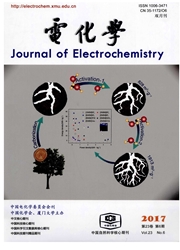

 中文摘要:
中文摘要:
直接甲酸燃料电池(DFAFCs)是一种很有前景的可用于移动电子设备的电源.钯对甲酸电催化氧化有很高的活性,但稳定性较差,容易失活;铂对甲酸电催化氧化的活性低于钯,但稳定性好.前期研究表明,高指数晶面铂纳米粒子对甲酸的电催化氧化活性显著高于低指数晶面铂纳米粒子.本文以碳纸为载体,应用方波电位法生长高指数晶面铂纳米粒子(HIF-Pt/C-paper),通过改变方波上下限电位,合成出不同粒径的二十四面体和偏方三八面体铂纳米粒子.进一步在碳纸上修饰一层碳黑微孔层并优化电沉积条件,制备出粒径约10 nm,载量0.069 mg·cm-2的HIF-Pt/C-paper作为DFAFCs的阳极催化剂.在甲酸浓度为3 mol·L-1时,测得30oC下单电池最大功率密度10.6 m W·cm-2,最大质量功率密度153.5 m W·mg-1Pt,是以1 mg·cm-2载量的商业60%(by mass)Pt/C(简称商业Pt/C)为阳极催化剂的电池的8.4倍.HIF-Pt/C-paper阳极DFAFCs在20 m A·cm-2条件下运行50 h,电压保持率为95%,显示出很好的稳定性.
 英文摘要:
英文摘要:
Direct formic acid fuel fuels(DFAFCs) are promising energy source for portable electronic devices. Palladium(Pd) is more active than platinum(Pt) for the formic acid electrooxidation. However, the stability of Pd is much poorer than that of Pt. Un fortunately, the ultra-low natural abundance of the Pt makes it extremely expensive and limits its application as a fuel cell catalyst.Boosting both the activity and stability of Pt nanoparticles to enhance their efficiency is urgent. As previous works illustrated,nanoparticles enclosed with high-index facets usually bare a higher activity toward fuel cell related reactions than those nanoparticles with low-index facet. We adopted in this study the square-wave potential(SWP) method to electrochemically synthesize highindex faceted Pt nanoparticles on carbon paper support(HIF-Pt/C-paper). By carefully tuning the deposition conditions such as upper potential limit(EU) and lower potential limit(EL) of the SWP, we successfully synthesized the tetrahexahedral Pt nanoparticles and trapezohedral Pt nanoparticles with different sizes ranging from 40 ~ 200 nm. Furthermore, when the electrodeposition was carried out on the XC-72 modified carbon paper, the high-index faceted Pt nanoparticles of ~ 10 nm in size with high density can be synthesize by delicately adjusting the electrodeposition conditions, the Pt loading on this electrode was determined to be 0.069 mg·cm-2 by ICP-MS. Using the HIF-Pt/C-paper as the anode of DFAFCs and 3 mol·L-1formic acid as the fuel, the maximum power density of single cell was 10.6 m W·cm-2under 30 °C, and 95% of the cell voltage had been maintained after 50 h test with current density equal to 20 m A·cm-2, which demonstrates a reasonable stability under the test condition. The Pt mass normalized maximum power density was 153.5 m W·mg-1Pt, which is 8.4 times as high as that of the DFAFCs using commercial 60%(by mass) Pt/C as the anode catalyst(Pt loading of 1 mg·cm-2). The enhanced mass activity of the
 同期刊论文项目
同期刊论文项目
 同项目期刊论文
同项目期刊论文
 期刊信息
期刊信息
